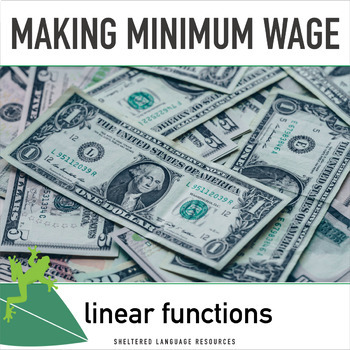Making Minimum Wage Week-Long Math Lesson Plans Focused on Linear Functions
- PDF
Also included in
- Buy the entire store of middle school math resources and get free updates for life!All my middle school math resources are created for mainstream classes serving ELLs along with native English speakers.The games and activities use sheltered instructional strategies to target academic vocabulary andPrice $199.00Original Price $240.00Save $41.00
Description
Engage your students with this five day math lesson plan about making minimum wage in the United States!
For just the cost of working one hour at minimum wage (depending on your state) you'll have a week's worth of engaging lesson plans to contextualize linear functions and what they actually MEAN for both your ELLs and your native English speakers.
Interested in a sneak peek at two of the strategies included in this resource?
Check out this FREE Resource:
FREE!: 2 Stand-Alone Resources from "Making Minimum Wage"
This lesson was designed using sheltered language strategies, including:
•Content and language objectives
•An Anticipation Guide
•Think-Write-Pair-Share prompts
•Graphic Organizers
•Scaffolded Exit Tickets with sentence frames
Intended grade level/Common Core State Standards:
-This lesson plan targets linear functions and is appropriate for students working with 8th grade math standards and above.
-Targeted CCSS include: 8.F.A.2, 8.F.A.3, 8.F.B.4, 8.EE.B.5, 8.EE.C.7.B, HSA.CED.A.1, HSA.CED.A.2, HSA.REI.B.3, HSF.IF.B.4, HSF.IF.C.7.A, HSF.LE.A.2.
Student math background needed:
In order to access this lesson plan as written, students will need to be familiar with the basics of linear functions including concepts like slope, y-intercept, and the slope-intercept form of a linear equation. It would be possible to teach those concepts at the same time as teaching this lesson.
Summary of Lesson Plans: (about 60 min per day)
Day 1: Build background knowledge and compare minimum wage in different parts of the U.S. using tables and graphs.
Day 2: Analyze graphs and introduce the concept of living expenses in the context of making minimum wage and modeling with linear functions.
Day 3: Create tables and graphs that focus on linear functions and modeling using the estimated living expenses for a single person in your area
Day 4: Extend the context to include living expenses for a single parent with one dependent child. Students complete a work sample-style task while writing and solving a linear function.
Day 5: Students work to estimate a reasonable “living wage” using estimated expenses and constraining the work week to 40 hours. A practice work sample is included for this day.
Bonus product included: Work sample assessment and answer key!
Teacher Tips:
-I like to staple all of the student materials together in a packet so they stay organized. I print the pages 2-sided to save paper.
-Take the time to let students brainstorm and discuss issues relating to minimum wage and living expenses.
-Review the content and language objectives with students and reflect on their attainment of them each day.






